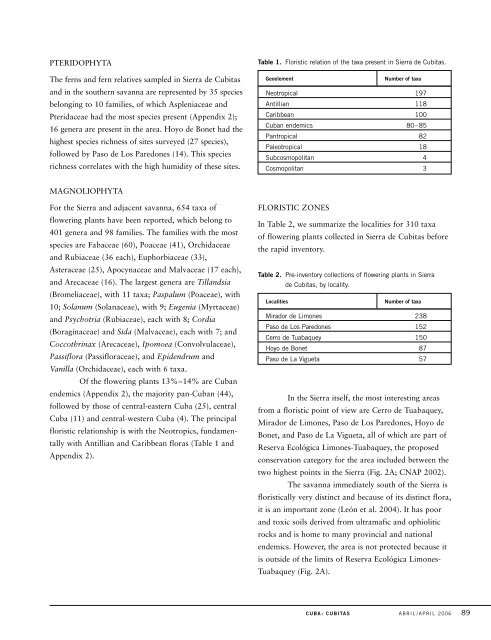Cuba: Camagüey, Sierra de Cubitas - The Field Museum
Cuba: Camagüey, Sierra de Cubitas - The Field Museum
Cuba: Camagüey, Sierra de Cubitas - The Field Museum
Create successful ePaper yourself
Turn your PDF publications into a flip-book with our unique Google optimized e-Paper software.
PTERIDOPHYTA<br />
<strong>The</strong> ferns and fern relatives sampled in <strong>Sierra</strong> <strong>de</strong> <strong>Cubitas</strong><br />
and in the southern savanna are represented by 35 species<br />
belonging to 10 families, of which Aspleniaceae and<br />
Pteridaceae had the most species present (Appendix 2);<br />
16 genera are present in the area. Hoyo <strong>de</strong> Bonet had the<br />
highest species richness of sites surveyed (27 species),<br />
followed by Paso <strong>de</strong> Los Paredones (14). This species<br />
richness correlates with the high humidity of these sites.<br />
MAGNOLIOPHYTA<br />
For the <strong>Sierra</strong> and adjacent savanna, 654 taxa of<br />
flowering plants have been reported, which belong to<br />
401 genera and 98 families. <strong>The</strong> families with the most<br />
species are Fabaceae (60), Poaceae (41), Orchidaceae<br />
and Rubiaceae (36 each), Euphorbiaceae (33),<br />
Asteraceae (25), Apocynaceae and Malvaceae (17 each),<br />
and Arecaceae (16). <strong>The</strong> largest genera are Tillandsia<br />
(Bromeliaceae), with 11 taxa; Paspalum (Poaceae), with<br />
10; Solanum (Solanaceae), with 9; Eugenia (Myrtaceae)<br />
and Psychotria (Rubiaceae), each with 8; Cordia<br />
(Boraginaceae) and Sida (Malvaceae), each with 7; and<br />
Coccothrinax (Arecaceae), Ipomoea (Convolvulaceae),<br />
Passiflora (Passifloraceae), and Epi<strong>de</strong>ndrum and<br />
Vanilla (Orchidaceae), each with 6 taxa.<br />
Of the flowering plants 13%–14% are <strong>Cuba</strong>n<br />
en<strong>de</strong>mics (Appendix 2), the majority pan-<strong>Cuba</strong>n (44),<br />
followed by those of central-eastern <strong>Cuba</strong> (25), central<br />
<strong>Cuba</strong> (11) and central-western <strong>Cuba</strong> (4). <strong>The</strong> principal<br />
floristic relationship is with the Neotropics, fundamentally<br />
with Antillian and Caribbean floras (Table 1 and<br />
Appendix 2).<br />
Table 1. Floristic relation of the taxa present in <strong>Sierra</strong> <strong>de</strong> <strong>Cubitas</strong>.<br />
Geoelement Number of taxa<br />
Neotropical 197<br />
Antillian 118<br />
Caribbean 100<br />
<strong>Cuba</strong>n en<strong>de</strong>mics 80–85<br />
Pantropical 82<br />
Paleotropical 18<br />
Subcosmopolitan 4<br />
Cosmopolitan 3<br />
FLORISTIC ZONES<br />
In Table 2, we summarize the localities for 310 taxa<br />
of flowering plants collected in <strong>Sierra</strong> <strong>de</strong> <strong>Cubitas</strong> before<br />
the rapid inventory.<br />
Table 2. Pre-inventory collections of flowering plants in <strong>Sierra</strong><br />
<strong>de</strong> <strong>Cubitas</strong>, by locality.<br />
Localities Number of taxa<br />
Mirador <strong>de</strong> Limones 238<br />
Paso <strong>de</strong> Los Paredones 152<br />
Cerro <strong>de</strong> Tuabaquey 150<br />
Hoyo <strong>de</strong> Bonet 87<br />
Paso <strong>de</strong> La Vigueta 57<br />
In the <strong>Sierra</strong> itself, the most interesting areas<br />
from a floristic point of view are Cerro <strong>de</strong> Tuabaquey,<br />
Mirador <strong>de</strong> Limones, Paso <strong>de</strong> Los Paredones, Hoyo <strong>de</strong><br />
Bonet, and Paso <strong>de</strong> La Vigueta, all of which are part of<br />
Reserva Ecológica Limones-Tuabaquey, the proposed<br />
conservation category for the area inclu<strong>de</strong>d between the<br />
two highest points in the <strong>Sierra</strong> (Fig. 2A; CNAP 2002).<br />
<strong>The</strong> savanna immediately south of the <strong>Sierra</strong> is<br />
floristically very distinct and because of its distinct flora,<br />
it is an important zone (León et al. 2004). It has poor<br />
and toxic soils <strong>de</strong>rived from ultramafic and ophiolitic<br />
rocks and is home to many provincial and national<br />
en<strong>de</strong>mics. However, the area is not protected because it<br />
is outsi<strong>de</strong> of the limits of Reserva Ecológica Limones-<br />
Tuabaquey (Fig. 2A).<br />
CUBA: CUBITAS ABRIL/APRIL 2006 89

















